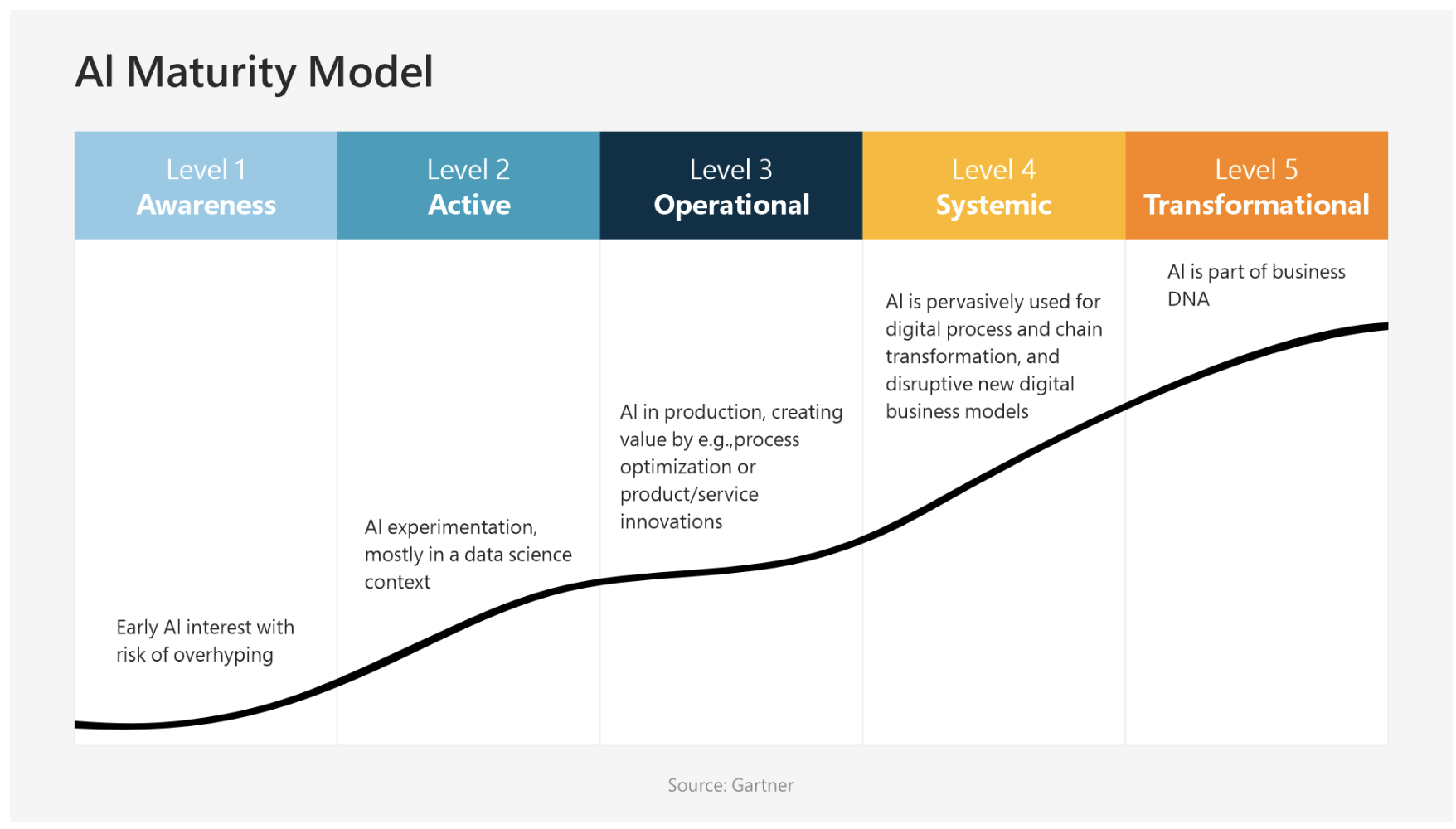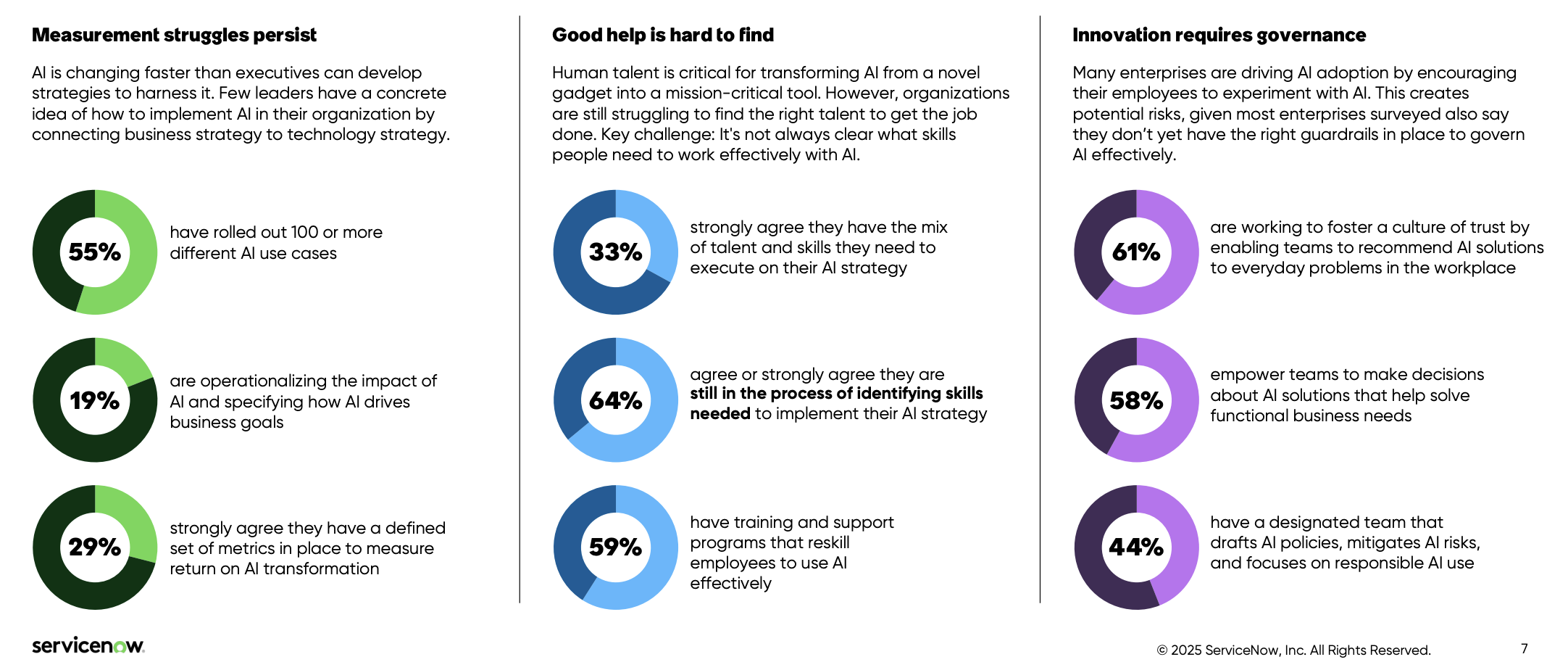
AI is becoming a defining capability for competitiveness, but the journey from experimentation to making AI a core driver of business transformation is anything but straightforward.
Many organizations wrestle with taking the initiative, getting substantial returns on investment, and an unclear strategy for scaling AI (or scaling AI agents).
This is where the concept of AI maturity becomes crucial: it provides a framework to assess how far an enterprise has advanced in turning AI from promise into practice.

A Capability Maturity Model for AI does exactly that. It provides a framework to assess where you are, chart a course to higher maturity, and scale AI with confidence.
The Reality Check: 95% of AI Pilots Are Failing
The MIT GenAI Divide: State of AI in Business 2025 exposes a hard truth: while AI dominates boardroom agendas, 95% of pilots are failing to deliver business impact, with only a tiny 5% generating measurable returns.
Models are capable enough; deployment is the problem area. Too often, pilots remain experiments that never mature, lacking the memory, contextual learning, and continuous improvement needed to embed AI into real workflows.
Meanwhile, employees are quietly turning to consumer-grade tools like ChatGPT, creating a "shadow AI economy" that highlights the gap between official corporate programs, and the agility users need.
For leaders, the message is clear: without a maturity roadmap, AI will remain stuck in pilot purgatory while true transformation slips further out of reach.
What is the AI Capability Maturity Model?
The AI Capability Maturity Model (AI CMM) is basically a roadmap for scaling AI across an enterprise. It borrows from the original Capability Maturity Model for software, which guided companies from messy, inconsistent practices to well-defined, repeatable, and continuously improving processes.
In the context of AI, maturity is preparing your organization. AI CMM looks across multiple dimensions: strategy, data, governance, talent, and how well AI is embedded into everyday workflows.
.jpg)
This helps leaders see where they are today, spot the gaps, and prioritize what's needed to move up the ladder. It ensures that as AI projects expand, governance, risk controls, and skilled teams grow alongside them. Without this balance, it's easy for AI to outpace compliance or operations and that's where costly missteps happen.
Most importantly, AI CMM reminds us that activity doesn't equal maturity. A company could have dozens of AI systems and still be "immature" if there's no oversight, explainability, or business alignment. The model forces leaders to ask the hard questions: Are our AI initiatives tied to real outcomes? Do we have governance in place? Are our models fair, explainable, and monitored?
The Five Levels of AI Maturity
Organizations evolve through successive maturity stages as they transition from isolated AI experiments to full-scale AI-driven transformation. This progression often follows a five-level maturity model, inspired by frameworks like CMMI, adapted to the fast-evolving AI landscape.
Different industry bodies label these stages slightly differently, but the underlying ideas are consistent. Here's a synthesized breakdown using the most current models, such as Gartner's and CGI's, merged into a clear, refined format:

Level 1 – Awareness / Ad-Hoc
At this stage, AI is mostly a topic of conversation rather than execution. Organizations may be excited about AI potential, yet there's no strategy, governance, or meaningful action. Any activity is driven by isolated individuals or small teams tinkering with AI tools or exploring proof-of-concepts, with limited coordination across the organization. This level is characterized by curiosity, not capability.
Level 2 – Active / Emerging
Organizations begin experimenting in earnest AI appears in pilot projects or isolated use cases. Teams may run proofs of concept or small-scale deployments. There's initial knowledge sharing and awareness, but efforts lack consistency, a formal process, and cross-functional collaboration. Strategy and governance are still nascent.
Level 3 – Operational / Defined
This marks a meaningful shift from experimentation to operationalization. At least one AI application is in production. Basic infrastructures like platforms, tools, and data pipelines are in place. Organizations have built standard methodologies, allocated budgets, and gained executive sponsorship for AI initiatives. Governance structures, such as internal review processes or ethical guidelines, begin to emerge.
Level 4 – Systemic / Managed
AI moves from being confined to individual projects to becoming embedded across the organization. Every digital project now considers AI by default. There's increased integration across business functions, AI literacy among employees, and robust risk mitigation practices. Continuous monitoring, performance tracking, and compliance mechanisms are in active use, ensuring that AI is both trustworthy and scalable.
Level 5 – Transformational / Optimized
AI is foundational at this level woven into every decision loop and business process. Organization-wide culture, workflows, and innovation are driven by AI. Self‑learning systems, explainability, and adaptability are standard, enabling continuous improvement. AI helps to transform business models, create entirely new offerings, and deliver significant competitive advantage.
Why Enterprise Leaders Need a Maturity Roadmap
AI adoption is accelerating across industries, but most enterprises are scaling breadth before building depth. Leaders are rolling out dozens of use cases, yet only a few can prove measurable impact, align talent with execution, or enforce governance with consistency. This creates a dangerous imbalance: innovation without accountability, experimentation without strategy, and progress without control.

That's why enterprises need a maturity roadmap. The AI capability maturity model provides the structure to bridge the gap between enthusiasm and effectiveness.
.jpg)
Align AI Investments with Business Goals
A roadmap forces clarity on why and where you are applying AI. Rather than doing AI for AI's sake, mature organizations tie AI projects to concrete business outcomes. Industry leaders emphasize anchoring AI strategy in broader business strategy – focusing on use cases that deliver real returns, not just deploying flashy technology.
This alignment ensures that AI initiatives have executive sponsorship and drive measurable value (revenue, cost savings, customer experience) that the board cares about. With a maturity model, each level has business criteria that must be met, keeping tech teams and business leaders on the same page about priorities.
Ensure Regulatory Compliance and Model Accountability
As AI deployments expand, so do scrutiny and risks. Enterprises, especially in regulated sectors like banking (BFSI), face strict expectations to manage AI responsibly. A maturity roadmap includes the development of governance structures to oversee AI ethics, bias, privacy, and safety.
For example, in late 2024, the Reserve Bank of India (RBI) convened a committee to develop a "Framework for Responsible AI" in financial services – a clear signal that regulators expect robust controls. Likewise, regulators worldwide (from the EU's AI Act to sectoral guidelines) are introducing rules for transparency, explainability, and risk management in AI.
A leader with a roadmap will proactively establish governance (audit trails, documentation, validation processes) to meet these requirements head-on. This avoids surprises like model failures or compliance penalties down the line.
Build AI That's Scalable, Explainable, and High-RoI
Fragmented AI efforts often hit technical and operational walls models that work in the lab but fail in production, or one-off solutions that can't be replicated. A maturity roadmap addresses this by gradually building the scalable infrastructure and skills needed for enterprise AI.
At higher maturity, organizations invest in things like unified data pipelines, MLOps platforms, and reusable model libraries. They also emphasize explainability and performance monitoring, so each new model in production strengthens – not weakens – the business. The payoff is AI systems that deliver consistent ROI and can be scaled across different use cases.
A recent global study found that "AI Pacesetter" organizations (the most mature) significantly outperform others in margins and growth. The roadmap helps in reaching that stage by institutionalizing best practices. Essentially, it's the difference between sporadic wins and a repeatable AI factory that churns out value.
Avoid Silos, Redundancies, and Tool Overload
One big reason AI initiatives stall is organizational dysfunction – different teams reinventing the wheel or competing for resources, and a profusion of disconnected tools. A maturity roadmap, owned by leadership (often through an AI Center of Excellence), helps break down silos.
It guides the formation of cross-functional teams (mixing business domain experts, data scientists, IT, and compliance) that work towards common goals. It also curbs "tool sprawl" by standardizing on approved platforms and frameworks as maturity grows.
Without this, companies often end up with multiple AI platforms, duplicate data science efforts, and no synergy. Leaders can confidently invest in AI, knowing there's a governance mechanism to coordinate projects and reuse successes enterprise-wide.
How to Start: A Practical AI Maturity Assessment Playbook
Reaching higher AI maturity is a structured journey. It begins with an honest assessment of where you stand today, followed by targeted actions to close the gaps. CIOs, CDOs, and AI program leaders can follow this five-step playbook to advance systematically:
.jpg)
Step 1: Take Stock of Current AI Assets
Start with a comprehensive audit of all AI activity across the enterprise: machine learning models, AI-infused RPA, analytics solutions, pilots, and shadow projects. Record their purpose, technology stack, ownership, and data sources.
- This inventory provides a baseline view of adoption.
- It highlights duplication, overlaps, and "low-hanging fruit" use cases that could scale quickly.
- Mature organizations maintain a living AI registry (or model inventory) as part of governance.
Step 2: Map Use Cases to Maturity Levels
Next, position each AI project and your organization overall on the AI maturity ladder. Assess across dimensions such as:
- Strategy: Is AI tied to business priorities?
- Data & Tech: Are data pipelines standardized?
- Skills: Do teams have the right capabilities?
- Governance: Are models reviewed and validated?
You may discover you're Level 3 in infrastructure but only Level 1 in governance. This honest mapping makes strengths and gaps visible.
Step 3: Identify Capability Gaps
Translate the assessment into a gap analysis. Typical gaps include:
- Governance: No AI review board, ethical guidelines, or model validation standards.
- Risk Management: Limited monitoring, drift detection, or audit readiness.
- Talent: Shortage of data scientists, ML engineers, or MLOps expertise.
- Reusability: One-off models with no shared libraries or feature stores.
Document each gap along with its business impact (e.g., "No centralized model repository = duplicated work = stuck at Level 2"). This helps prioritize fixes.
Step 4: Build a Cross-Functional Roadmap
With gaps identified, chart a practical roadmap of initiatives to move up the maturity curve.
- Involve business leaders, IT, data science, and compliance teams from the start.
- Prioritize initiatives by impact and feasibility (e.g., launch an AI Governance Council, set up an AI CoE, or deploy a unified data platform).
- Define milestones (e.g., "Achieve Level 3 maturity by year-end by training 100 staff and deploying an enterprise AI platform").
- Keep it iterative: plan for the next 3, 6, and 12 months, then reassess.
For BFSI and regulated industries, embedding compliance, model risk management, and audit readiness into the roadmap is non-negotiable.
Step 5: Establish KPIs and Track Progress
Finally, define key performance indicators that measure both technical progress and business impact. Examples:
- Technical: number of models in production, average cycle time from development to deployment, model accuracy and drift rates, and AI system uptime.
- Business: percentage of decisions augmented by AI, revenue lift, cost savings, improved customer satisfaction, or risk reduction.
High-maturity enterprises use dashboards and regular reviews to keep leadership aligned. This rigor separates "AI leaders" from those stuck in pilot purgatory. Over time, KPIs should evolve — early on, you may track pilots later the percentage of enterprise workflows automated or enhanced by AI.
Wrapping it Up!
AI success isn't defined by isolated experiments it's defined by how well an organization can scale, govern, and continuously improve its AI capabilities. The AI Capability Maturity Model provides a clear roadmap to move from scattered pilots to enterprise-grade transformation.
For leaders in BFSI and beyond, maturity isn't optional; it's what separates those who achieve sustained competitive advantage from those who stall in proof-of-concept mode. By embracing a structured maturity framework, enterprises can ensure their AI journey delivers not just experiments but measurable, lasting impact.





.png)





.png)




.png)
.svg)


